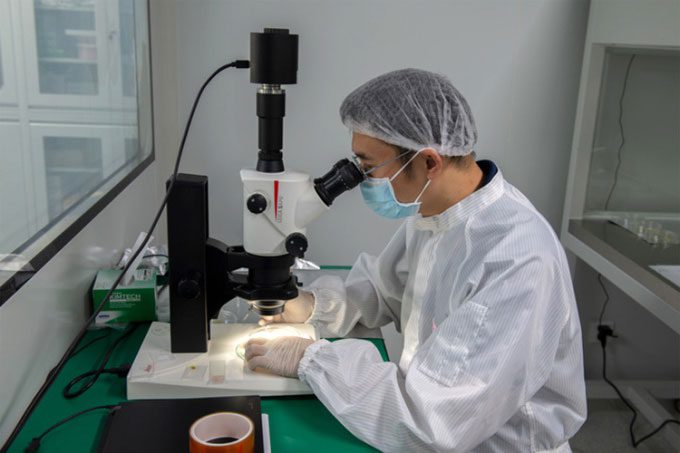China showcased high-resolution images of lunar soil particles brought back by the Chang’e 5 mission on September 10.

Researcher Yang Wei observes a lunar soil sample under a microscope. (Photo: CAS).
During the initial examination of lunar soil from the Chang’e 5 mission, geologist Yang Wei, who joined the Institute of Geology and Geophysics at the Chinese Academy of Sciences (CAS) in 2010 to develop analytical tools for lunar rock samples collected by China’s space program, was captivated by the details he found.
“The bright moon was a mystery to me as a child. Now, I am fortunate to work with lunar soil samples and want to share what I see with everyone,” Yang stated.
On September 10, an exhibition took place at the Central Academy of Fine Arts in Beijing, showcasing images of lunar soil particles—smaller than a grain of flour or the cross-section of a human hair—captured under polarizing and electron microscopes. Each image was accompanied by notes on its weight, age, and composition.

A lunar soil particle (basalt) captured by a polarizing microscope. (Photo: CAS).
This collaborative effort between the Institute of Geology and Geophysics, the Central Academy of Fine Arts, and the Institute of Computer Technology aims to present “the highest resolution and most accessible images of lunar soil particles in human history,” the organizers emphasized.
According to Yang, lunar soil and terrestrial soil are formed in very different ways. While soil on Earth is shaped by wind, water, and biological activities, lunar soil is the result of continuous bombardment by meteoroids and cosmic particles.
The soil particles brought back by Chang’e 5 in December 2020, averaging about 50 micrometers in size, were collected from a vast volcanic complex in the Oceanus Procellarum plain.
The exhibition will feature four types of lunar soil: basalt, glass, breccia (a mix of older rocks), and agglutinate (a combination of rock, minerals, and glass fragments created from the bombardment of micro-meteoroids). However, no actual soil will be displayed, only high-resolution images due to policy restrictions.

Cross-section of a glass particle in a lunar soil sample captured by an electron microscope. (Photo: CAS)
The exhibition is expected to last for a month before moving to other locations in Beijing and potentially across China. Despite funding shortages and COVID-19 restrictions, the team hopes to expand the project and inspire more people, including children in China, through the integration of science, technology, and art.
All particles photographed for this exhibition belong to lunar soil sample Chang’e 5 number CE5C0600YJFM00402, with a total weight of 1.5g. To date, over 50g of lunar soil has been distributed by the China National Space Administration to researchers in China, with subsequent findings published in leading journals such as Science and Nature.


















































